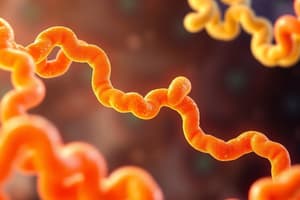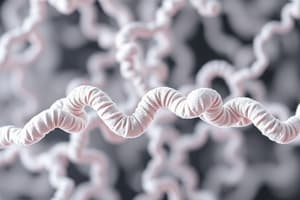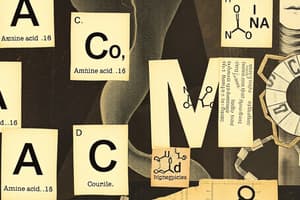Podcast
Questions and Answers
What is the isoelectric point (pI) for glycine?
What is the isoelectric point (pI) for glycine?
- 9.60
- 12.00
- 5.97 (correct)
- 2.34
During the first stage of glycine titration, which group loses its proton?
During the first stage of glycine titration, which group loses its proton?
- R group
- —NH3+ group
- —H2N group
- —COOH group (correct)
What happens at the midpoint of the first titration stage of glycine?
What happens at the midpoint of the first titration stage of glycine?
- All protons are removed.
- Only the R group is deprotonated.
- The solution becomes strongly alkaline.
- pH equals the pKa of the deprotonating group. (correct)
How many buffering zones are present for one amino acid?
How many buffering zones are present for one amino acid?
In the second stage of glycine titration, from which group is a proton removed?
In the second stage of glycine titration, from which group is a proton removed?
What is the pKa value for the —COOH group of glycine?
What is the pKa value for the —COOH group of glycine?
What characterizes the zwitterionic form of glycine?
What characterizes the zwitterionic form of glycine?
How is the pI of amino acids with charged R groups determined?
How is the pI of amino acids with charged R groups determined?
What is the primary structure of a protein?
What is the primary structure of a protein?
Which of the following amino acids is classified as nonpolar and aliphatic?
Which of the following amino acids is classified as nonpolar and aliphatic?
What is the role of enzymes in cellular reactions?
What is the role of enzymes in cellular reactions?
How are amino acids structurally joined together in proteins?
How are amino acids structurally joined together in proteins?
Which amino acid is positively charged?
Which amino acid is positively charged?
What distinguishes the various types of amino acids?
What distinguishes the various types of amino acids?
Which of the following statements about amino acids is incorrect?
Which of the following statements about amino acids is incorrect?
What is the significance of amino acids being referred to as the 'alphabet' of protein structure?
What is the significance of amino acids being referred to as the 'alphabet' of protein structure?
Flashcards
Amino Acids
Amino Acids
The building blocks of proteins, with 20 different types.
Peptide Bond
Peptide Bond
The covalent bond that links amino acids together in a protein chain.
Protein Primary Structure
Protein Primary Structure
The linear sequence of amino acids in a protein.
Enzyme
Enzyme
Signup and view all the flashcards
Nonpolar Aliphatic R-group
Nonpolar Aliphatic R-group
Signup and view all the flashcards
Polar Uncharged R-group
Polar Uncharged R-group
Signup and view all the flashcards
Charged R-groups
Charged R-groups
Signup and view all the flashcards
Aromatic R-groups
Aromatic R-groups
Signup and view all the flashcards
Amino Acid Properties
Amino Acid Properties
Signup and view all the flashcards
Amphoteric Nature
Amphoteric Nature
Signup and view all the flashcards
Isoelectric Point (pI)
Isoelectric Point (pI)
Signup and view all the flashcards
Titration Curve of Amino Acid
Titration Curve of Amino Acid
Signup and view all the flashcards
pKa Value
pKa Value
Signup and view all the flashcards
Zwitterionic Form
Zwitterionic Form
Signup and view all the flashcards
Amino Acid Classification
Amino Acid Classification
Signup and view all the flashcards
Charged R-groups De-protonation
Charged R-groups De-protonation
Signup and view all the flashcards
Study Notes
Proteins and Amino Acids
- Proteins are composed of 20 different amino acids joined in various combinations and sequences.
- This allows for a vast array of protein types with diverse functions, including enzymes, hormones, antibodies, transporters, and structural components like muscle fibers, feathers, and spider webs.
- Enzymes are highly specialized catalysts for almost all cellular reactions, making them crucial for understanding life's chemistry.
- Amino acids are the building blocks of proteins, like letters forming words.
- Amino acids have characteristic side chains with unique chemical properties, which determines their role in protein function.
- Amino acids bond together through peptide bonds, forming a linear sequence called the primary structure.
Amino Acid Classification
- Amino acids are categorized by their side chain (R-group) properties.
- Nonpolar, aliphatic: Glycine, Alanine, Proline, Valine, Leucine, Isoleucine, Methionine
- Polar, uncharged: Serine, Threonine, Cysteine, Asparagine, Glutamine
- Positively charged: Lysine, Arginine, Histidine
- Negatively charged: Aspartate, Glutamate
- Aromatic: Phenylalanine, Tyrosine, Tryptophan
Amino Acid Properties
- Amino acids are amphoteric, meaning they can act as both acids and bases.
- They can donate or accept protons (H+).
- The ability to donate a proton correlates to the acidity and affects the pH(pK).
- The titration curve of an amino acid reveals critical information.
Titration Curve and pI
- The titration curve plots pH against the amount of added base, providing important information about the pKa values of the amino acid's ionizing groups.
- pKa values indicate the pH at which half of the amino acid molecules are deprotonated.
- The isoelectric point (pI) is the pH where the amino acid carries a net zero charge, existing primarily as a zwitterion.
- For amino acids without ionizable R-groups, the pI is the arithmetic mean of the pKa values of the acidic and basic groups.
- Amino acids with charged R-groups have a more complex titration curve with three distinct stages.
Studying That Suits You
Use AI to generate personalized quizzes and flashcards to suit your learning preferences.




